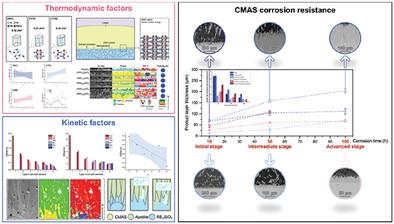Our official English website, www.x-mol.net, welcomes your feedback! (Note: you will need to create a separate account there.)
Medium-Entropy Monosilicates Deliver High Corrosion Resistance to Calcium-Magnesium Aluminosilicate Molten Salt
Advanced Science ( IF 15.1 ) Pub Date : 2024-04-19 , DOI: 10.1002/advs.202400736 Zeyu Chen 1, 2 , Yongzhe Wang 1 , Yiling Huang 1 , Fan Peng 1 , Chucheng Lin 1 , Wei Zheng 1 , Xuemei Song 1 , Yaran Niu 3 , Yi Zeng 1
Advanced Science ( IF 15.1 ) Pub Date : 2024-04-19 , DOI: 10.1002/advs.202400736 Zeyu Chen 1, 2 , Yongzhe Wang 1 , Yiling Huang 1 , Fan Peng 1 , Chucheng Lin 1 , Wei Zheng 1 , Xuemei Song 1 , Yaran Niu 3 , Yi Zeng 1
Affiliation

|
For decreasing the global cost of corrosion, it is essential to understand the intricate mechanisms of corrosion and enhance the corrosion resistance of materials. However, the ambiguity surrounding the dominant mechanism of calcium-magnesium aluminosilicate (CMAS) molten salt corrosion in extreme environments hinders the mix-and-matching of the key rare earth elements for increasing the resistance of monosilicates against corrosion of CMAS. Herein, an approach based on correlated electron microscopy techniques combined with density functional theory calculations is presented to elucidate the complex interplay of competing mechanisms that control the corrosion of CMAS of monosilicates. These findings reveal a competition between thermodynamics and kinetics that relies on the temperatures and corrosion processes. Innovative medium-entropy monosilicates with exceptional corrosion resistance even at 1500 °C are developed. This is achieved by precisely modulating the radii of rare earth ions in monosilicates to strike a delicate balance between the competition in thermodynamics and kinetics. After 50 and 100 h of corrosion, the thinnest reactive layers are measured to be only 28.8 and 35.4 µm, respectively.
中文翻译:

中熵单硅酸盐为钙镁铝硅酸盐熔盐提供高耐腐蚀性
为了降低全球腐蚀成本,有必要了解腐蚀的复杂机制并提高材料的耐腐蚀性。然而,极端环境下钙镁铝硅酸盐(CMAS)熔盐腐蚀的主导机制的模糊性阻碍了关键稀土元素的混合搭配,以提高单硅酸盐对CMAS腐蚀的抵抗力。本文提出了一种基于相关电子显微镜技术与密度泛函理论计算相结合的方法,以阐明控制单硅酸盐 CMAS 腐蚀的竞争机制的复杂相互作用。这些发现揭示了热力学和动力学之间依赖于温度和腐蚀过程的竞争。开发出创新的中熵单硅酸盐,即使在 1500 °C 的温度下也具有出色的耐腐蚀性。这是通过精确调节单硅酸盐中稀土离子的半径以在热力学和动力学竞争之间取得微妙的平衡来实现的。腐蚀 50 小时和 100 小时后,测得最薄的反应层分别仅为 28.8 和 35.4 µm。
更新日期:2024-04-24
中文翻译:

中熵单硅酸盐为钙镁铝硅酸盐熔盐提供高耐腐蚀性
为了降低全球腐蚀成本,有必要了解腐蚀的复杂机制并提高材料的耐腐蚀性。然而,极端环境下钙镁铝硅酸盐(CMAS)熔盐腐蚀的主导机制的模糊性阻碍了关键稀土元素的混合搭配,以提高单硅酸盐对CMAS腐蚀的抵抗力。本文提出了一种基于相关电子显微镜技术与密度泛函理论计算相结合的方法,以阐明控制单硅酸盐 CMAS 腐蚀的竞争机制的复杂相互作用。这些发现揭示了热力学和动力学之间依赖于温度和腐蚀过程的竞争。开发出创新的中熵单硅酸盐,即使在 1500 °C 的温度下也具有出色的耐腐蚀性。这是通过精确调节单硅酸盐中稀土离子的半径以在热力学和动力学竞争之间取得微妙的平衡来实现的。腐蚀 50 小时和 100 小时后,测得最薄的反应层分别仅为 28.8 和 35.4 µm。



























 京公网安备 11010802027423号
京公网安备 11010802027423号